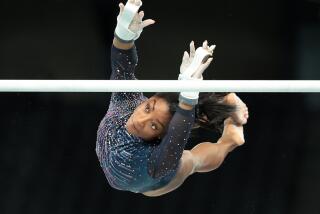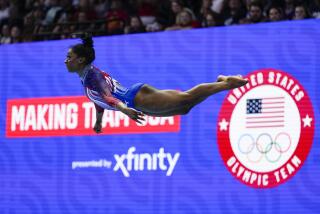Things Are Looking Up for High-Flying Pilot on U.S. Aerobatic Team
- Share via
Until six years ago Cecilia Aragon was terrified just to drive a car on the freeway. Then she went for a ride in a friend’s four-seat airplane that changed her life.
“As soon as we got back on the ground I signed up for flying lessons,” Aragon recalled. Now, as the first Latino pilot ever to make the U.S. aerobatic team, she is training for the World Aerobatic Championships in Le Havre, France, in July.
Aerobatics is short for aerial acrobatics, a sport that the 32-year-old Aragon compared to figure skating in the sky with an airplane. Pilots are judged on the accuracy and timing of their loops, spins and rolls.
At the world championships, Aragon will compete in a four-minute freestyle, a six-minute freestyle, a set of compulsory maneuvers, and what she called “the real killer,” the unknown compulsory. For this last category, pilots must fly a series of moves they have been given the previous day and never practiced.
Aragon’s ability to visualize the maneuvers she will fly makes the unknown compulsory her strongest suit. “The key is being able to focus and image yourself in the airplane,” she said. “I have had to develop that skill because it’s a lot cheaper than having to go up and fly it.”
Aragon said a six-minute flight in an aerobatic competition can be completely draining. “But it’s also just thrilling and beautiful. . . . You can go up, you can go down, you can do anything you want. It’s the ultimate freedom,” she said.
She sees aerobatics, which requires a combination of technical precision and the rhythm of dance, as the fulfillment of one of mankind’s oldest dreams. “People didn’t really invent flying for transportation. It was to fly like birds,” Aragon said.
“I can’t even describe the exultation I feel when I’m flying,” she continued. “When I become one with the airplane I’m almost a dancer in the sky.”
For the 5-foot-2, 100-pound Berkeley resident, aerobatics is also the fulfillment of a childhood dream. The shy child of a Chilean father and a Filipina mother, she was one of only a few Latinas in her school in Indiana. Her classmates used to beat her up for being different, she said.
“When I was a little girl I used to blow out the candles on my birthday cake and say, ‘I wish I could fly.’ Maybe it was a wish for freedom,” she said.
When she was 17, Aragon came west to study math and literature at Caltech in Pasadena. “I liked Los Angeles a lot better than Indiana,” she said. One of the things that made her feel more comfortable here was living in an area with people of different ethnic and racial backgrounds.
Aragon approached flying with the same dedication that made her a top student. She earned her instructor’s certificate within a year, and won the second aerobatics competition she entered.
Though she is modest about her achievements, no one else has ever made the national team so soon after learning to fly. “To get it in six years is just incredible,” said Jack Ashby, who keeps several planes at the Nut Tree Airport near Vacaville, where Aragon gives lessons to members of her nonprofit Flying Taildraggers Club.
“Anybody that can do what she’s done, in the way she’s done it, in the time she’s done it, has to be not only a very dedicated person but have a tremendous amount of willpower,” Ashby added.
“I was kind of the underdog,” admitted Aragon, the only California pilot to make the national squad. “I’m the only member of the team that was of average income.”
Unlike its competitors in July’s “Olympics of aerobatics,” the 10-member U.S. team is not sponsored by the government, so the pilots must raise their own funds and furnish their own planes. Aragon’s custom-built Sabre monoplane cost her $120,000.
She estimates that transport, maintenance, fuel and other competition expenses will total about $77,000. To raise that amount she works as a computer programmer and flight instructor, and is hitting the fund-raising circuit to encourage donations.
If she performs well at the world championships and at an August air show in Miramar, Aragon hopes to attract a corporate sponsor. “Maybe I’ll get my face on the back of the Kellogg’s cereal box,” she joked.
Even if it doesn’t make her rich, aerobatics has had a lasting effect on Aragon’s personality. Before learning to fly, she had always been an extremely timid person, she said. For example, she said, “Learning how to drive a car was a major event for me.”
“My story isn’t just learning how to fly, it’s overcoming fear,” she said. “If I can do these maneuvers a few feet off the ground, I can do anything.”
More to Read
Go beyond the scoreboard
Get the latest on L.A.'s teams in the daily Sports Report newsletter.
You may occasionally receive promotional content from the Los Angeles Times.






